How to Write a Job Ad that Doesn't Suck!
As a Seedcamp VP from a design and product background, I'm regularly asked for hiring advice. Especially from folks who have had an open role for several weeks (sometimes even months), but haven't been getting the quality or volume of candidates they've been hoping for. The first thing I usually do is ask to take a look at the job ad, as this is generally where the problem starts.
The Hiring Landscape Has Changed
I think folks are used to writing job ads in an environment of abundance; where there are tons of qualified designers, developers and product managers looking for their next job, and your role is to narrow the field down to only the most qualified. As such, you spend the first half of the job ad talking about how great your company is and how lucky the person seeing the ad will be if they get the role. You then write a long list of requirements, intended to put off all but the most qualified candidates.
There's an argument that this kind of approach might have worked in the past, and may still work for companies with a very strong brand presence who genuinely are wanting to narrow down the field. Although even then research has shown that job ads which use overly gendered language or contain long lists of requirements tend to bias against female applicants. So my advice is generally to ditch the long lists of bullet point requirements and run your job ads through a gender bias filter first.
Job Ads Are Becoming Less Effective
In my experience, while still common, these more traditional job ads are becoming less and less effective. Why? Because talented candidates are finding themselves in a sellers market. Hiring has exploded of late, and there are only so many qualified candidates around. As such, rather than trying to limit the number of applications to make the hiring manager's job easier, the role of a job ad is to stand out in an incredibly crowded market; to make people who currently have a pick of roles consider you over somebody else. As such your job ad needs to be just that, and “advert”—and by that I mean something that really sells you, your company and the role you’re looking to fill, rather than simply sharing the fact that a position has comer available. So how do you do this effectively and well?
Take A User-Centred Approach to Your Job Ads
The answer to the above question is surprisingly simple. Essentially you need to take a user centred approach to your job ad, rather than a company centred approach. This means thinking about what the candidate wants rather than what you want, and centereting the conversation around their needs rather than yours. With this in mind, what are designers, developers and product managers looking for at the moment?
The Importance of Including a Salary
People start looking around for a new role when something isn’t quite working in their current role. One of the most obvious things people are looking for is to increase their earnings, so I’m always a little surprised when job ads don’t mention the salary, let alone the whole package.
I think one of the reasons companies choose not to list salary details is they’re honestly a little embarrassed. They know (or at least believe) that they’re not going to be able to compete with larger and more established companies when it comes to pay, so don’t even try; reasoning that “we’ll sell the candidate on the role first, and then discuss salary later”.
Now this approach might work if the rest of the job ad does an amazing job at selling the role. However, as I mentioned earlier, most of the job ads I see do a terrible job of this, which means you’re left reading a mediocre job ad with no indication of whether the role pays more than you’re currently getting, the same, or significantly less.
Candidates aren’t stupid, so if they see a job ad with no salary details, the good candidates are going to assume the salary is going to be much lower than what they’re looking for, and possibly lower than what they’re currently earning.

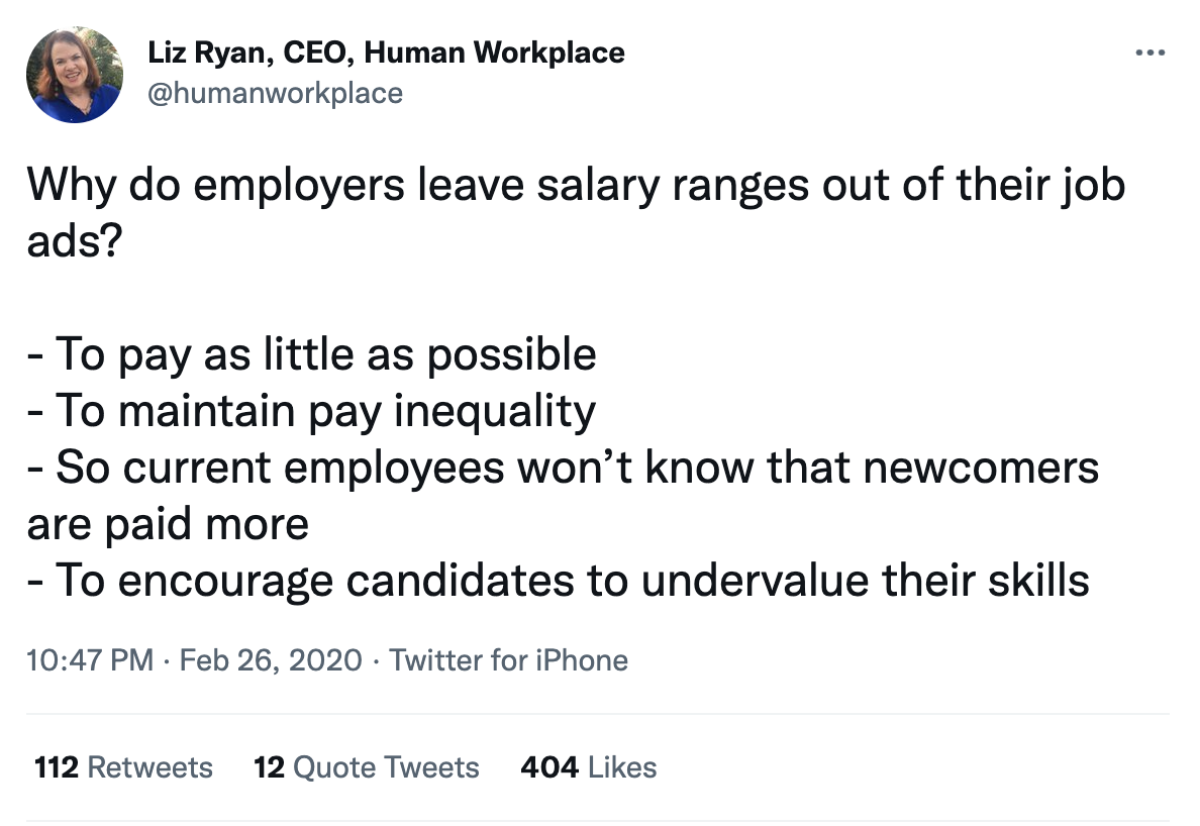
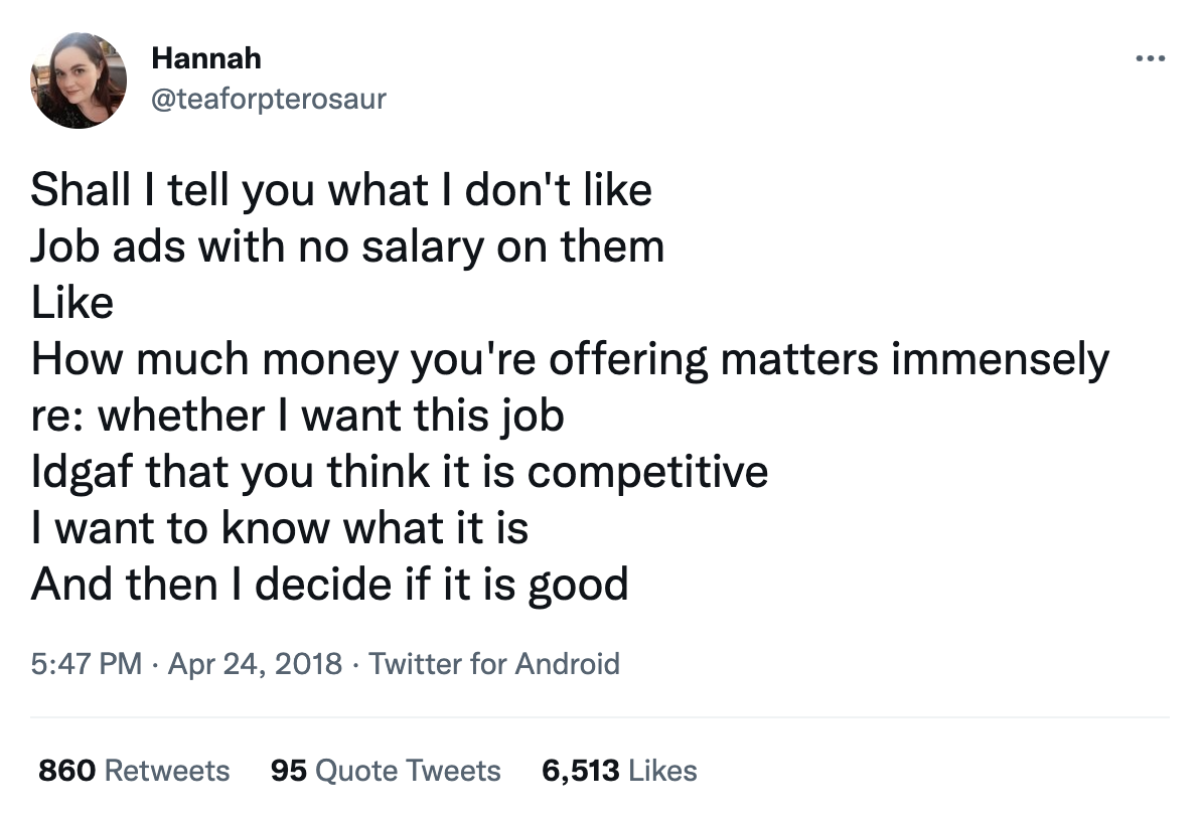
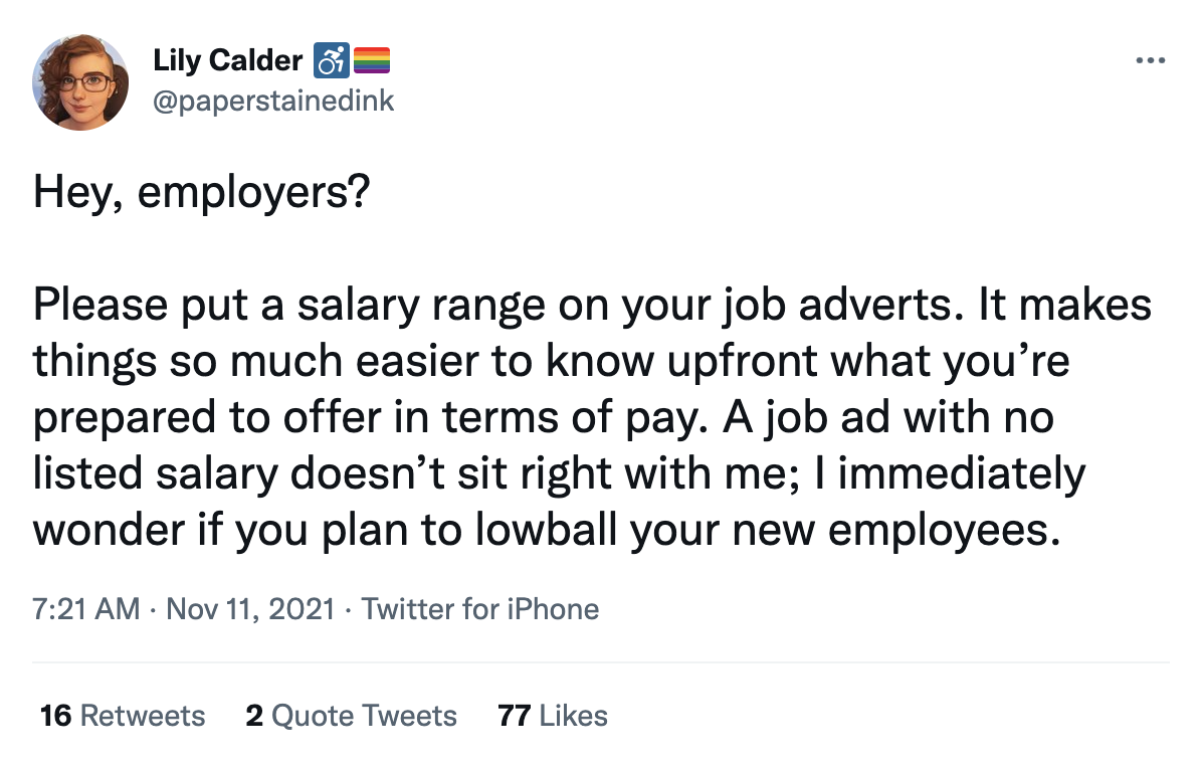
Not Including A Salary Sends the Wrong Signal
With numerous other companies talking to them about roles it’s just not worth the effort in applying for a job with no salary posted, as you don’t want to waste a tonne of time and effort only to find out later down the line that they can’t afford you. As such, the best applicants simply won’t apply. This is one of the major reasons why a lot of founders find the calibre of applications is much lower than expected; because the lack of salary puts off the best people and skews the applicant pool more junior.
Ironically I’ve found that early stage start-ups actually pay pretty well. Maybe not as much as their big tech counterparts in Silicon Valley, but often more than traditional companies. Good candidates often don’t realise this because the last time they spoke to a start-up was 4-5 years ago when rates were much lower. However the amount companies are raising has gone up so much the past few years, and the hiring market is so much more competitive, that you’re probably offering much more than your candidates think, so don’t be afraid of adding it to your job as you may be shooting yourself in the foot otherwise.
Consider the Whole Package
Another thing to remember is that it’s not just about the salary, but the entire package, and one big thing start-ups have in their favour is the ability to offer meaningful share options. Unfortunately a lot of candidates in the UK don’t really value options, seeing them as a nice to have extra that probably won’t turn into anything meaningful, so they discount it. This isn’t helped by job ads which use super vague language like “generous options package” or offers which include a percentage ownership figure. Much better to spell out what those options could be worth, as my friend Chris did in this recruiting tweet.
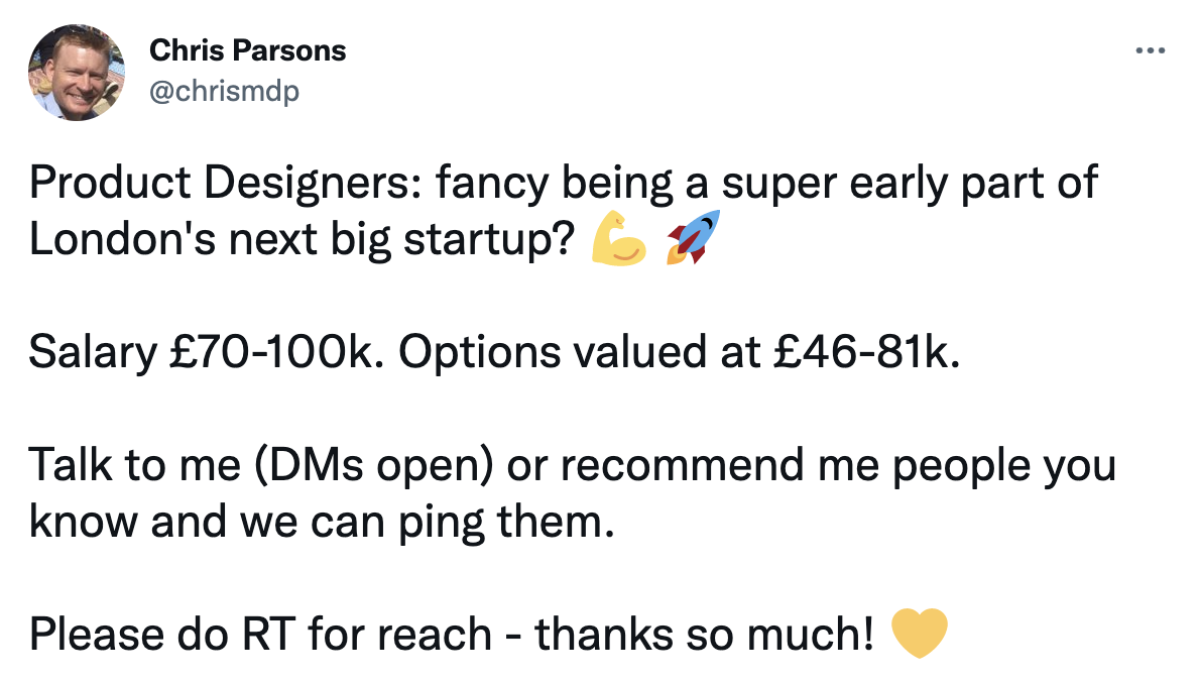
If that’s not enough, Chris also created a salary and options calculator for his company, allowing prospective candidates to see the effect of choosing more salary or more options.
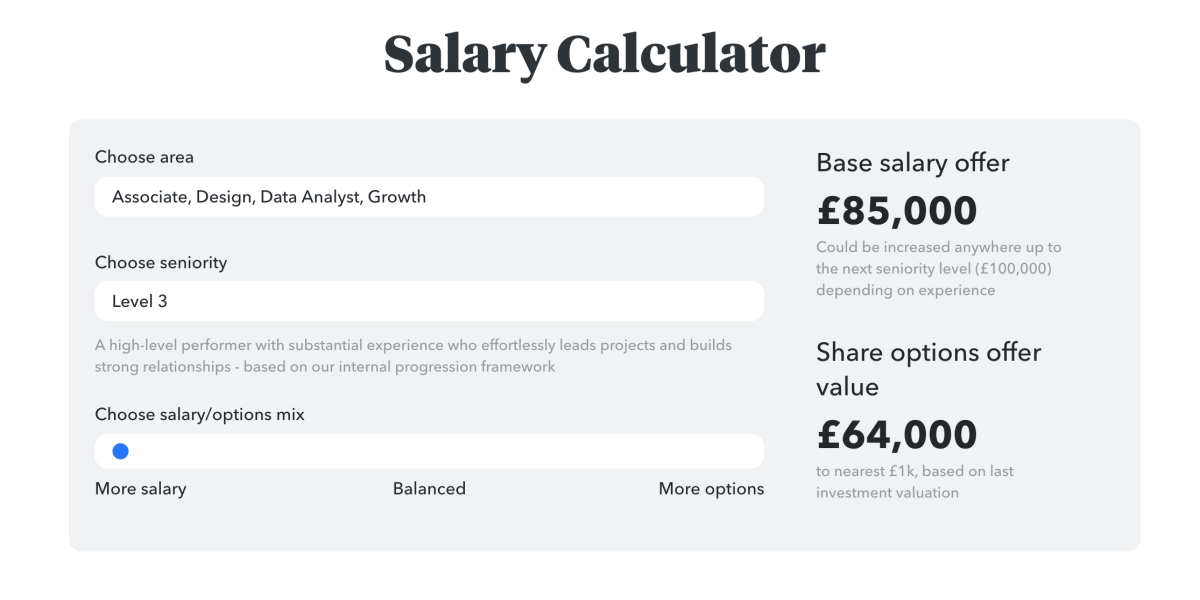
It’s worth remembering that while a competitive salary is table stakes, smart candidates will be looking at the whole package, and this may include a bunch of other things beyond salary.
Craftspeople are Motivated by Learning and Mastery
For instance, most of the designers and developers I know are heavily motivated by learning, so want to work in an environment that will help them grow as individuals. One of the reasons a lot of practitioners shy away from early stage start-ups is the fear they’ll be nobody else on the team to learn from. As such you can address those concerns in one of two ways.
Communicate a Culture of Learning
First off you can bake learning into the company culture. So in the job ad you need to talk about the wonderful learning opportunities the candidate is going to have. For early stage start-ups this may be about getting the opportunity to build a new product from the ground up, supported by amazingly talented founders, investors, advisors and engineers. I know one friend who got convinced to leave Twitter to join a super early stage start-up because the founders realised my friend had aspirations to run their own start-up one day and explained how much they’d be able to learn about raising funding, growing teams and go-to-market strategy in the process. So find out what sort of personal growth the candidates are optimising for, and make sure that comes across in your ad.
For more established companies you can focus on things like team learning. For instance at Clearleft we used to run staff training sessions, bring in external speakers, organise conferences and run team hack-weeks. All of these activities made candidates realise the amount of learning opportunities they’d have here, versus another company that maybe paid a bit more.
Bake Learning into the Package
The second thing you can do is bake learning opportunities into the package itself. Things like a generous conference budget, access to a free training portal, or support from a coach or mentor. I think the latter is especially important for landing your first designer or product manager, as they’ll lack the sort of peer support or mentorship they’d get at larger companies, so offering free coaching can effectively dismiss those concerns and be a big draw.

More Reasons Why People Switch Jobs
Once you have the package sorted, you need to think about the other reasons folks may be leaving their last role. Along with salary and learning opportunities comes influence and status.
A lot of designers and PMs leave larger organisations because they struggle to see clear routes for advancement, or those routes may be slow or related to other managers leaving. One of the great things about working at a start-up is the opportunities for advancement and learning grow as the company grows. As such you may be able to land an amazing engineer, designer or product manager by letting them know that as the company scales, they’ll scale with it. This may mean that those folks will be hands-on practitioners for the first 12 months, but very soon you’re going to want them to recruit, grow and lead their own team. This is a wonderful opportunity for a senior IC (individual contributor) looking to make the move into management.
Titles Count
Another thing you can offer is a title. Largely because titles don’t cost you anything, but often mean a lot to candidates when it comes to mapping out their career journeys. For instance, “Founding Designer” sounds a lot more impressive than “Middleweight Designer” and hints at the level of influence they're likely to have. Which brings us onto the next element which is working conditions.
Show What a Great Place you are to Work
A lot of folks will leave their current company not for a higher salary or a more impressive title, but simply to improve their working conditions. Maybe they work for an overly aggressive boss, or are part of a “work hard, play hard” culture that always expects “110%”. While these sorts of sentiments are increasingly rare, I still see the occasional job ad looking for “rock stars” and “ninjas”, which feels juvenile at best and potentially toxic at worst.
Today's modern knowledge workers want to be treated as adults, respected as individuals and work for companies with a strong work-life balance (although even mentioning work-life balance can be a bit of a red flag to some). This is especially true of more experienced practitioners with some bargaining power, as well as folks who have carerer responsibilities (which sadly affects more women and people from underrepresented backgrounds).
Address Common Start-up Misconceptions
Startups have some signalling issues they need to get over here, as the public perception of startup life isn’t necessarily a healthy or balanced one. Instead there’s the perception of working crazy long hours and being in permanent crunch mode. They also have the perception of being run by ferociously driven founders who know what they want and expect you to deliver it. While this may be true, it doesn’t necessarily say ”collaborative environment where my views and experience will be respected”. So in order to attract quality applicants, startups in particular need to work hard to dispel some of those myths.
This super simple job description from early stage start-up Nette, contains none of the usual “work hard, play hard” language. Instead it feels like it was written by a genuinely nice person who cares about other people and wants to build a healthy and collaborative company culture.
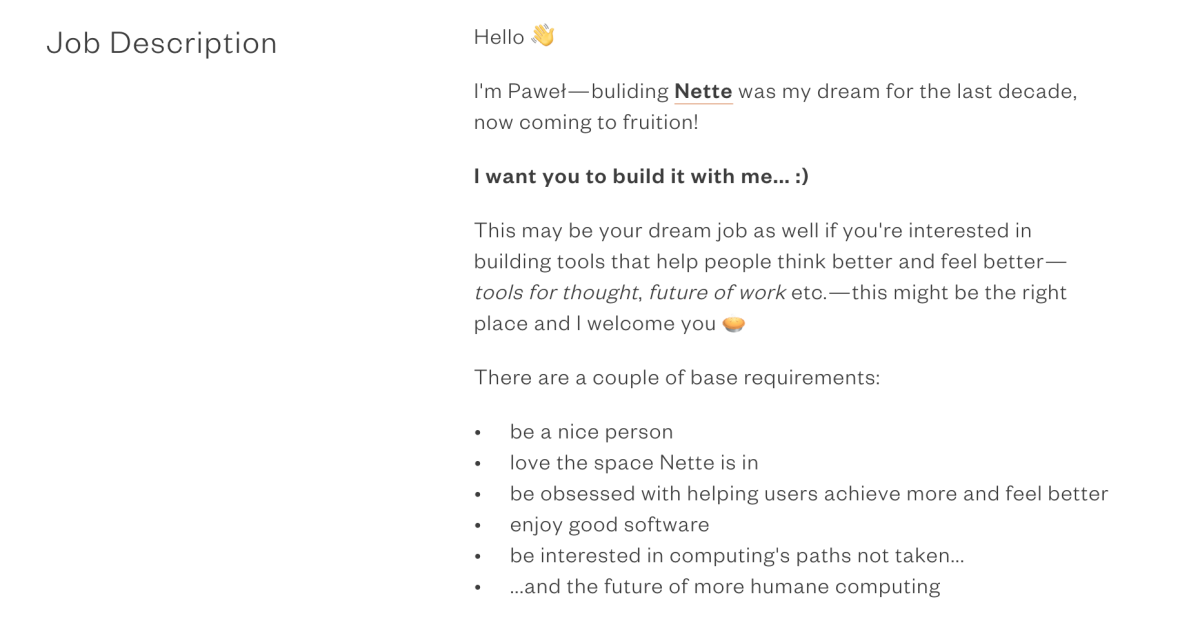
Demonstrate your Commitment to Design
As well as wanting a nice working environment, a lot of practitioners will leave their company because they’re frustrated by how little influence or involvement they have in decision making. Somebody higher up the chain makes a decision about what feature needs to be built and the team is expected to go away and build it. This runs counter to everything designers, developers and product managers are taught about how effective, high performing teams work, and is often described in negative terms as a “feature factory”. As such, if you want to hire the best talent possible, you need to make it clear in your job description that the candidates will be working as part of a mature and high functioning process where their input is going to be sought and valued rather than overlooked and ignored.
This video job ad does a great job of outlining the design and development culture at this otherwise largely unknown bank. It taps into many of the frustrations I’ve heard from other practitioners and clearly states that “it’s not like that here”. Instead you’re going to get to work with a bunch of super talented people who care about doing things the right way. If you’re looking to hire designers, developers and product managers, this video is a masterclass in positioning, so I highly recommend you check it out.
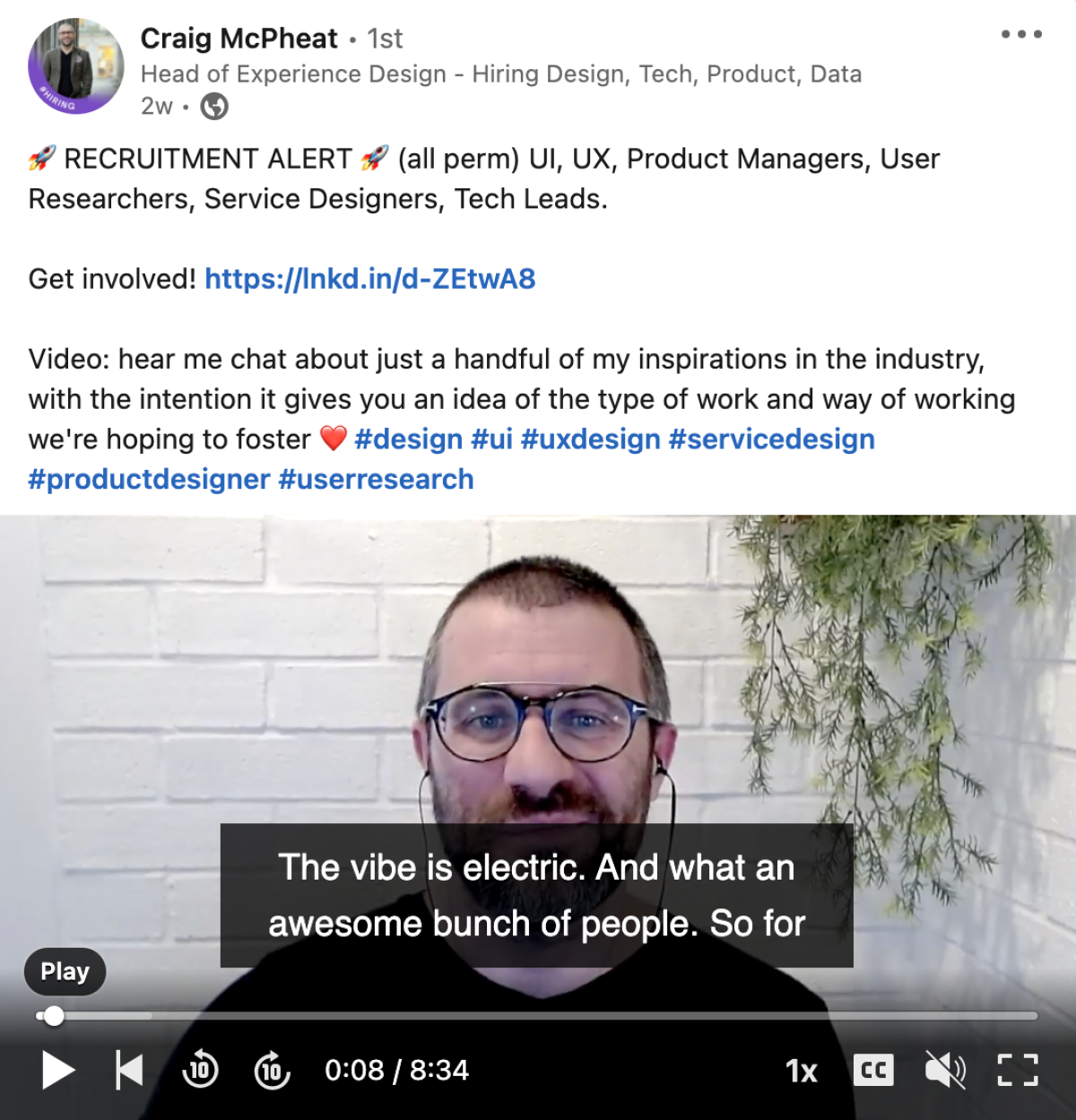
More Benefits of Video Ads
This video does two other things really well. First off the hiring manager comes across as a really kind and caring person; the sort of person you’d want to have as a boss. This is much easier to do over video than it is in written text, so I suggest exploring video as part of your job marketing mix.
The other thing this video does really well is signal belonging. The hiring manager explains all the things he values, knowing that these are things the audience will value as well. He then goes on to list a bunch of industry influencers he knows and respects (in full disclosure I’m listed in there as well), helping cement the team as one that deeply cares about the latest industry trends. This is often in stark contrast to the majority of job ads that fail to connect with applicants with a sense of belonging and understanding.
Creating a Sense of Belonging
Another job ad that resonates a sense of belonging is this one from Linear. It’s essentially a long form story from the founders, sharing their sense of magic discovering the Web; a sense of magic they know the people reading it will also share. They then go on to tie their company mission to that sense of belonging, in what can only described as a masterclass in recruitment copy.
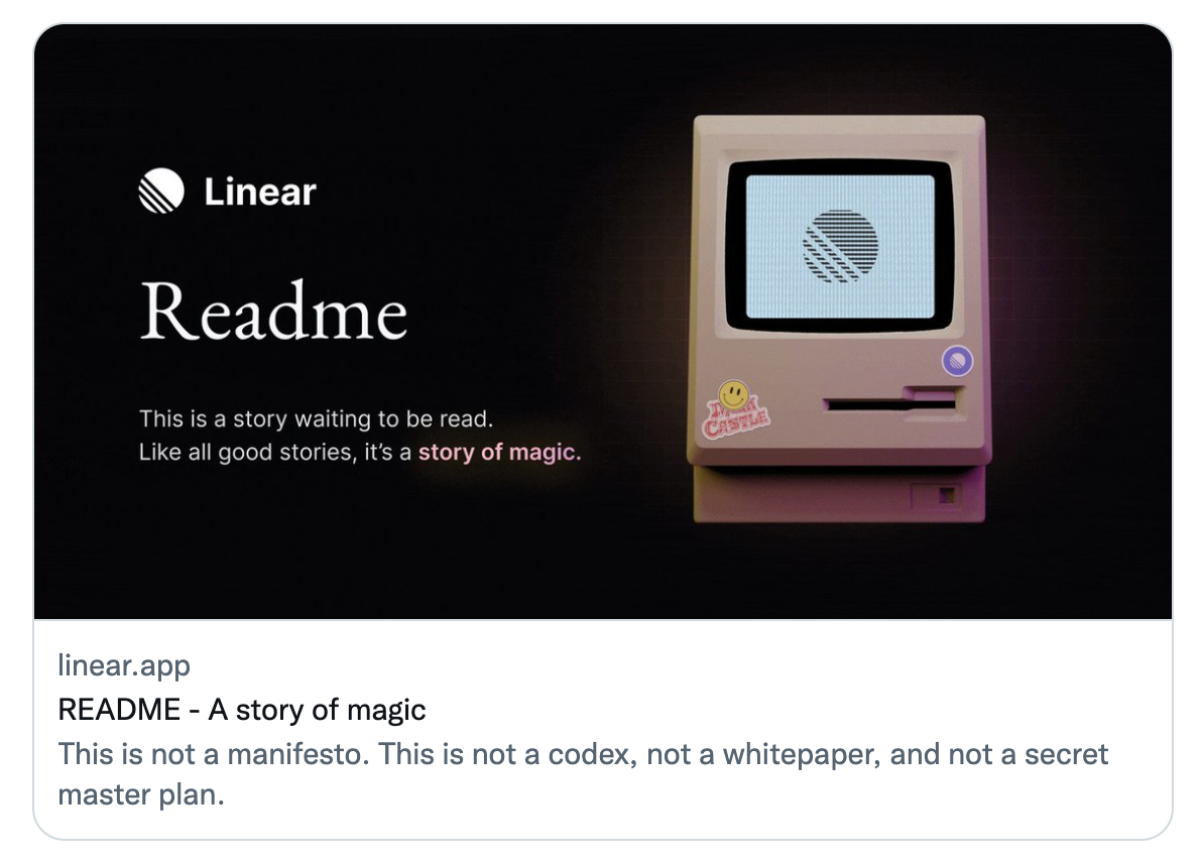
This job ad was written so well, it ended up going viral and being shared around tonnes of potential candidates. With the competition for talent being so tough at the moment, and access to talent so hard, I think we’re going to see a lot more campaigns like this in the coming months and years.
Brining it All Together
Not everybody can write job ads this well. However it goes to show you how impactful changing the dynamic of the typical job ad can be, and making the candidate the hero of the story, rather than the company or founder. So next time you’re crafting a job ad, think deeply about the person who’s going to be reading the ad, what it says (or doesn’t say) about what it’s like working for your company, and what you need to do in order to stand out from the crowd in a meaningful and personable way. That, and make sure you include the salary band on offer.